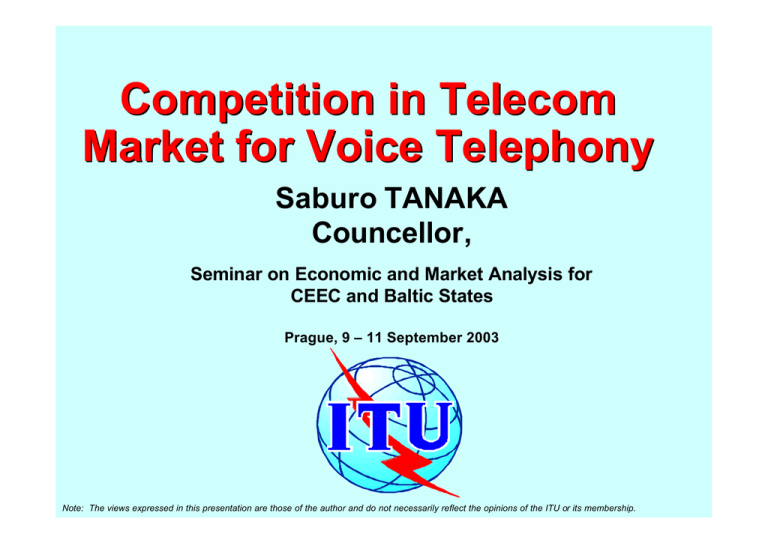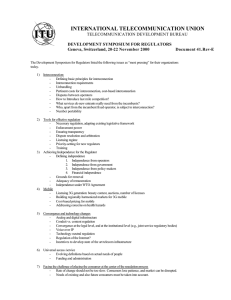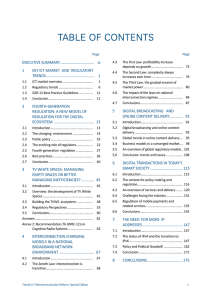Competition in Telecom Market for Voice Telephony Saburo TANAKA Councellor,
advertisement

Competition in Telecom Market for Voice Telephony Saburo TANAKA Councellor, Seminar on Economic and Market Analysis for CEEC and Baltic States Prague, 9 – 11 September 2003 Note: The views expressed in this presentation are those of the author and do not necessarily reflect the opinions of the ITU or its membership. Competition in Voice Telephony Agenda l Status of competition ð Competition in Voice Telephony ð How traffic flow in the competitive market l Role of Regulators l Importance of Interconnection ð Regulatory and technical issues ð Economic issues l Importance of tariff rebalancing 2 Private, competitive, mobile and global By country 2% 13% 39 Status of telecom Ot privatization h 2001 113 85% Fully or partly private incumbent Other private operators (e.g. mobile) No private operators 49 By telecom revenue Status of telecommunication privatization , by country and by share of global revenue, 2001 Percentage of countries with competition for selected services, 2001 100 Monopoly 90 Competition 80 70 In % 60 50 40 30 20 10 0 Basic services Leased lines Wireless local loop Cellular Source: ITU World Telecommunication Regulatory Database, 2001 Cable TV VSAT ISPs Percentage of countries allowing competition for basic services 100 70 Monopoly Competition Monopoly 90 Competition 60 80 50 70 60 In % In % 40 30 50 40 30 20 20 10 10 0 0 Local Long distance International Source: ITU World Telecommunication Regulatory Database, 2001 Africa Americas Asia-Pacific Arab States Europe World Competition in ISP and Leased Line Markets, by Region ISPs 100 Monopoly Leased line services 100 Competition 90 Monopoly 90 80 Competition 80 70 70 60 In % 60 In % 50 50 40 40 30 30 20 20 10 10 0 Africa Americas Asia- Arab Pacific States Europe World Source: ITU World Telecommunication Regulatory Database, 2001 0 Africa Americas Asia-Pacific Arab States Europe Competition in Mobile Cellular Services 100 Monopoly 90 Competition 80 70 In % 60 50 40 30 20 10 0 Africa Americas Asia-Pacific Source: ITU World Telecommunication Regulatory Database, 2001 Arab States Europe Legal status of competition Distribution by country, 2001 37% 38% 43% Long distance Int'l Local Legal status of telecommunication competition, by country, 2001 Monopoly Competition 78% 86% Mobile Internet Competition in Voice Telephony 10 Growth in fixed line teledensity, Chile and Argentina, 1986-2000 Teledensity, in Chile and Argentina 25 20 1990: Privatization w ith 7-year exclusivity in Argentina 15 Exclusivity extended by 3 years in Argentina 10 5 1988: Privatization and competition in Chile 0 1986 1988 1990 1992 1994 1996 1998 2000 Competition in Voice Telephony 11 Growth in mobile teledensity, Hong Kong SAR and Singapore, 1988-2000 Mobile penetration rate, per 100 inhabitants 90 Six additional PCS licences awarded in 1996 80 70 60 50 40 Hongkong SAR: Mobile competition introduced in 1988 for analogue 30 Additional competition introduced w ith digital mobile in 1993 Singapore: Mobile competition delayed until April 1997 20 10 0 1988 1990 1992 1994 1996 1998 2000 Teledensity with rising rank Country China 2000 17.8 1990 0.6 Rank 2000 95 V iet Nam 4.2 0.1 141 189 48 Botsw ana 21.6 2.1 91 129 38 El Salvador 21.8 2.4 90 125 35 Jamaica 34.1 4.5 71 106 35 Hungary 67.4 9.6 43 78 35 Mauritius 38.6 5.4 67 100 33 Chile 44.4 6.7 61 93 32 Philippines 12.4 1.0 112 143 31 Morocco 13.3 1.6 107 136 29 Paraguay 20.7 2.7 92 120 28 Cambodia 1.2 0.0 167 194 27 17.2 2.4 98 125 27 137.0 31.4 5 31 26 45.6 8.6 60 85 25 Cape Verde Taiw an, China Poland Rank 1990 159 Change 64 Teledensity with falling rank Country 2000 1990 Rank 2000 Armenia 15.6 15.7 102 60 -42 Iraq 2.9 3.9 149 109 -40 Tajikistan 3.6 4.5 143 105 -38 Uzbekistan 6.9 6.9 128 92 -36 Kyrgyzstan 7.9 7.2 125 90 -35 Angola 0.7 0.8 177 146 -31 Liberia 0.2 0.4 190 162 -28 DPR Korea 4.6 3.8 138 111 -27 96.1 58.6 33 6 -27 Turkmenistan 8.4 6.0 123 97 -26 Cuba 4.4 3.1 140 115 -25 Moldova 16.5 10.6 99 74 -25 Kazakhstan 12.5 8.0 111 87 -24 1.0 0.8 171 149 -22 22.7 13.6 87 66 -21 Canada Comoros Ukraine Rank 1990 Change Traditional regime: Joint provision of service 14 Country A Country B X X Emerging regime: Market entry and interconnection 15 Jointly provided circuit Country A Country B X X X Circuit provided by operator B International simple resale (ISR) (By-passing accounting rate) Country A Operator A Country B PSTN Operator B Interconnect IWF Leased lines Once a foreign carrier accepts the benchmark rate, it can negotiate ISR arrangements with US carriers Telephone service using data transmission (By-passing accounting rate) Country A Country B VSAT Operator A Interconnection PSTN É Voice is packetized = data transmission Telephone regulations do not apply IP Telephony (by-passing accounting rate) Terminating Network PSTN/ISDN /PLMN IP Network IW F Local or distributed function Local or distributed function IW F Call initiated from P S T N / I S D N / P L M N to P S T N / I S D N / P L M N PSTN/ISDN /PLMN Originating Network Call from International Telecommunication Network (ITN) to another ITN via IP-based Network T0208500-00 (106147) CALL BACK using Accounting Rates Alternative calling procedures Using AR Call-Back Country A Call-Back 1.2$ 1.0$ 0.8$ 1.5$ 2.0$ Country B 4.5 $ Country C 3.5$ Interconnection of two outgoing calls in country A 7 Mobile tromboning (using accounting rate) Operator X or Operator A’s facility in another country International boundary Operator A’s Int’l facility Operator B’s Int’l facility Operator A’s national network É Caller A Operator B’s mobile network High Interconnection charge È Called B Refile and other practices using accounting rate system Operator in A sends traffic to operator in C under an arrangement of exclusivity 1 C in A Orig nation B i Dest Operator in C declares traffic to B on transit through A A C • Operator in A is a partner of operator in C • Settlement rates A/B > C/B B 3 A C B igin ation r O tin s De Operator in B receives traffic at settlement rate C/B instead of A/B 2 Operator in C “re-labels” the traffic as originated in C B 4 Calling opportunity in the world 5.0% 5.0% 0.3% 7.5% More than 75% of calls involve mobile 19.9% 1993 89.7% 52.7% 26.7% Mobile-tomobile 19.9% 1998 Mobile-tofixed 25.0% 2003 Source: ITU Fixed-Mobile Interconnect website: http://www.itu.int/interconnect 23.4% Fixed-tofixed Fixed-tomobile 25.0% Delivering international voice traffic in 2002 Traditional Traditional bilateral bilateral settlement settlement rate rate system system Via Via aa wholesale wholesale carrier carrier 30% 15% 20% Originating international voice traffic Direct Direct dealing dealing with with the the terminating terminating country country 70% 65% Refile Refile via via a third third country country Sender Sender keeps keeps all all exchange exchange of of traffic traffic Via Via aa point point of of presence presence in in the the terminating terminating country country Competition in Voice Telephony 24 So, what’s the problem? l Competition is everywhere but.. ð Incumbents, New-comers and Regulators are not ready l Accounting rates are the traditional way of sharing revenues from int’l services ð BUT, creates incentives among recipient countries to sustain rates at high level ð Accounting rate system not well-adapted to competitive market environment l Strong pressure to move towards a cost-oriented system ð BUT, a cost-oriented system would be asymmetric ð US want cost-oriented but reject asymmetric charges for call termination l How to calculate cost ? ð How interconnection charge should be determined 0.35 Movement of settlement rates 0.327 T>50 (as per Recommendation D.140, Annex E) 35<T<50 0.3 20<T<35 10<T<20 Settlement rates (SDR) 0.25 5<T<10 0.245 0.251 1<T<5 0.225 0.2 0.21 0.05 0.142 0.139 0.088 0.043 0.183 0.165 0.171 0.15 0.1 TAL 0.206 0.162 0.118 T<1 0.215 0.137 0.115 0.116 0.122 0.099 0.108 0.083 0.074 0.039 0.115 0.038 0.102 0.061 0.038 0.148 0.113 0.114 0.104 0.101 0.085 0.058 0.039 0 1998 1999 Years 2000 2001 2002 Competition in Voice Telephony 26 Solutions & difficulties l New Remuneration system (adopted) ð Termination charge system ð Settlement rate system ð Special arrangement l Difficulty to quickly implement those systems ð Condition is to reach cost-oriented rate, but ð No cost data or model for some administrations ? SG3 developed principles and TAF, TAS, TAL cost models l Transitional arrangements (review at WTSA) ð To facilitate staged reduction to cost based rate ð to avoid sudden fall of revenue (smooth transition) l SG3 developed: ð Guidelines for negotiation Annex E to Recommendation D.140 “indicative target rates” by Teledensity (T) Band, in SDR (and US cents) per minute. T<1 1<T<5 5<T<10 10<T<20 20<T<35 35<T<50 T>50 0.327 SDR 0.251 SDR 0.210 SDR 0.162 ( SDR 0.118 SDR 0.088 SDR 0.043 SDR 43.7¢ 33.5¢ 28.0¢ 21.6¢ 15.8¢ 11.8¢ 5.7¢ (end 2001) 2 7 (end 2001) Low income FCC : 23 ¢ (January 2002/2003) (end 2001) (end 2001) Lower middle FCC : 19 ¢ (January 2001) end 2001) Upper middle 19 ¢(J.2000) (end 2001) (end 2001) High income FCC : 15 ¢ (January 1999) Note: The correspondence between teledensity band and income group shown in the bottom row is intended to be approximate, not precise. Source: ITU-T SG3 Report. 1 SDR = US$1.39. Guidelines to facilitate the negotiation The following non-binding guidelines could be applied when negotiating accounting rates and accounting rates share in the international service: 1 Each party should ensure that; i.e., all information to be given to the other party should be credible in order to lead the negotiations into right direction. 2 The parties should negotiate freely and make agreements voluntary, any kind of coercion should be avoided. Each party should act constructively, any offer, proposal, action, etc. should be directed towards reaching an agreement. Complex concepts should be simplified as much as possible. 4 Each party should act time-saving, any delay should be avoided. 5 Regular re-negotiations and future amendments should be possible. 6 Until such time as an appropriate dispute settlement arrangement may be approved by the ITU with respect to accounting rates, both parties should have the possibility to consult a person or institution for mediation. Addition to Recommendation D.140 1 accountingnrates for international telephone services should be cost-orientated and should take into account relevant cost trends; 2 each Administration should apply the above principle to all relations on a non-discriminatory basis; Accordingly, international calls should not be treated any less favorably than comparable national calls. Alternative proposal from Vietnam: Accordingly, under normal circumstances (where tariff rebalancing has been effectively achieved) international calls should be treated any less…. The importance of interconnection l Key to developing competitive markets ð Interconnection is the main driver of growth and innovation in telecom market, it promote efficient infrastructure development ð But constructing a sound interconnection framework is no easy task l Approaches to Interconnection Policy ð National approach – by 2000 101 countries had established interconnection regulatory framework ð Regional Approach – European Union (interconnection directive), CITEL (Guidelines and Practices for Interconnection Regulation), APEC (Recommended Principles for interconnection), TRASA(proposed interconnection guidelines) l WTO Reference Paper on Regulatory Issues ð Puts forward a series of interconnection commitments: - provide interconnection at any technically feasible point - non discrimunatory terms, conditions and rates - in a sufficiently unbundled and timely fashion - calls for transparency Key Interconnection Rules in the WTO Reference Paper Interconnection with “Major Supplies”must be available - At any technical feasible point in the network - In a timely fashion - At cost orientated rates - On non discriminatory and transparent terms - On an unbundled basis - At non-traditional interconnection points if requester pays charges Procedure Procedures for interconnection to major suppliers must be made public Transparency Agreements of major suppliers’ model interconnection offers must be made public An independent entity (which may be the Dispute resolution regulator) must be available to resolve interconnection dispute within a reasonable time frame Competition in Voice Telephony 32 Regulatory and technical issues l Policy makers must resolve such basic questions as: ð which carriers are required interconnection ð How the costs will be calculated and recovered, and ð At what points in the PSTN interconnection should occur l Regulatory issues ð Establishing guidelines in Advance (without it, interconnection negotiation are frequently protracted, delaying the introduction of competition) ð Introducing competition require “dominant carriers” to interconnect with other carriers ð Cost orientation: excessive prices deter market entry, hinder competition, end user suffer and can provide a pool of revenue l Technical issues ð Points of interconnection: incumbent operators permit interconnection with their networks at any technically feasible point ð Dialling Parity and Pre-selection: Call-by-call customer selection or Operator pre-selection by pre-subscription ð Quality of Interconnection Service Economic issues The economic issues involved in interconnection largely come down to question of cost: cost definition, cost measurement, cost allocation and cost recovery l How can interconnection costs be measured? ð Theoretical Frameworks (Historica, Fully Distributed costs, LRIC) ð Cost study Approaches (Top-Down, Bottom-Up, Outside-In) l Interconnection charge ð ð ð ð ð Cost based charges Retail-based charges Price Caps “Bill and Keep” or “Sender Keeps All” Revenue Sharing Cost Model OBJECTIVES BUSINESS DECISION SUPPORT •Pricing and Product Planning •Investment evaluation •Economics of direct/transit routing FINANCIAL CONTROL REGULATORY COMPLIANCE •Monitor actual performance and compare with plan and past trends •Set D.140 as globally acceptable standard •Cost control •Rationalize tariff charges •Identify Cross Subsidy •Derive TAR, USO MARKETING TECHNOLOGY •Minimize opportunity for arbitrage •Enhancement towards global technology •Generate more revenue by increased traffic •Long term cost/benefit of technology and options •Impact of technology on global relations Costing Methodologies METHODOLOGIES ACCOUNTING CONVENTION HISTORICAL COST ACCOUNTING •Actual costs incurred CURRENT COST ACCOUNTING •Cost of today of providing service •Mirrors competitors potential cost COSTING APPROACH FULLY DISTRIBUTED COST APPROACH •All costs are allocated to services INCREMENTAL COST APPROACH •Incremental costs only •Often long-run incremental costs only Competition in Voice Telephony 36 No much differences if… l Current cost accounting is used ð FDC=Historical Cost is no more relevant l Costs of efficient services provision is used ð this should be the aim of all operators ð spare capacity (legitimate if transparency) ð Disagreement on time horizon to achieve this l Principle of cost causality is applied (ABC) ð Common cost must be attributed to the service on the basis of the causality priniple ð However an exhaustive application of an ABC approach may be very costly l Need for cost recovery realised appropriately ð IC approach should contain a markup Agreed General principles l Principle of transparency : The open availability of information used in the cost deviation process in order to allow comprehension of the final rate from the vantage point of an external analyst l Principle of practicability : The ability to implement a costing methodology with reasonable demands being placed on data availability and data processing in order to keep the costing exercise economical, yet still useful l Principle of cost causality : The demonstration of clear causeand-effect relationship between service delivery on the one hand and the network element and other resources used to provide it on the other hand, taking into account the relevant underlying cost determinants (cost drivers) l Principle of reasonable contribution to common costs : Costing methodologies should provide for a reasonable contribution to common costs l Principle of efficiency : The provision of a forecast of cost reductions that result from a more efficient combination of resources Cost Study Methodologies Top Down (Total Company costs) Outside In (Proxy inputs results) Service Unit cost Results Bottom UP (Facility, operating cost inputs) Interconnection Rates in Selected European Countries Calling Party Pays (CPP). In US $ per minute. European fixed-to-mobile interconnect charges, (US$/min) Norway 0.156 UK 0.16 Denmark Fixed-tomobile 0.17 Netherlands 0.18 Belgium 0.18 Spain 0.20 France 0.20 Finland Mobile-tofixed DOUBLE TRANSIT 0.22 Austria 0.23 Italy 0.23 Sw itzerland Lowest Best-practice (20%) guideline Mobile-tofixed SINGLE TRANSIT 0.21 Sweden Germany EU, range of interconnect rates, (US cents per min.) Highest Mobile-tofixed LOCAL 0.24 0.30 0 5 10 15 20 25 30 Interconnection rates in selected non-European countries Calling Party Pays (CPP) vs. Receiving Party Pays (RPP). In US$ per minute. China RPP countries 0.0096 0.0012 0.007 0.000 0.008 HK SAR 0.008 0.008 Singapore Canada Mobile-to-fixed interconnect rate Malaysia Fixed-to-mobile interconnect rate Guatemala Mexico 0.000 0.009 Sri Lanka 0.000 USA Costa Rica Cambodia 0.020 0.020 Dom. Rep. Philippines RPP CPP CPP countries 0.017 0.017 Mobile-to-fixed interconnect rate 0.034 0.034 0.047 0.047 0.026 0.20 0.050 0.070 0.042 0.078 0.051 0.205 Average 0.010 0.005 Botswana 0.056 0.105 Antigua Fixed-to-mobile interconnect rate 0.052 0.208 0.293 0.293 TAL average interconnection charges MobileMobile Interconnecti on charge Fixed-Mobile Interconnectio n charge Mobile-Fixed Interconnectio n charge Fixed-Fixed Interconnection charge 2001 0.155 0.1418 0.0546 0.0269 2002 0.1406 0.13505 0.0461 0.0252 Average TAF average interconnection charges Average Fixed to Mobile Interconnect charge Mobile to fixed Interconnect charge Local Mobile to fixed Interconnect charge Single transit Mobile to Fixed Interconnect charge Double transit 0.167 0.078 0.096 0.150 Conclusion and Recommendation l Erosion of traditional system of accounting rates for exchange of international traffic ð Domestic interconnect fees will be dominant mode l Major price cuts in international calls ð Availability of new infrastructures ð Impact of Internet pricing model (distance and duration independent) l Mobiles exceed fixed-line phones worldwide ð Introduction of “third generation” mobiles ð Generational shift, as new users reject fixed-lines “ Interconnection and tariff rebalancing”


